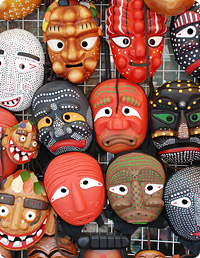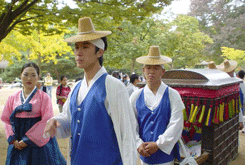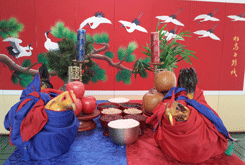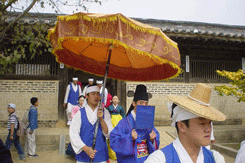Life
Saju
Saju literally denotes the four pillars of an individual in the traditional concept, which involves such elements as the time, day, moth and the year of one's birth and is regarded as important information for foretelling a man's future. They are thought to influence one's destiny. These critical data are referred to as the Saju. When an initial agreement of marriage is made, the bridegroom's grandfather sends a matchmaker with his personal letter to the bride's house master.
Gunghap and Engagement
A thorough examination of the four pillars of the man and woman determines if they can live harmoniously together as a married couple. Referred to as Gnghap divination, the future fortunes of a couple's life together are divined by a fortuneteller, an event which is considered an essential part of the marriage process. If the Gunghappredicts difficulty or misfortunes, the two parties may lose interest and cancel plans for marriage. When the four pillars and Gunghap are considered acceptable, the couple becomes engaged. In tradition, the two families get together at the girl's house or sometimes at a hotel or restaurant, but never at the boy's house. The two young people exchange gifts, and a piece of hand-made white paper on which the man's four pillars have been written is ceremoniously presented to the girl's family. A discussion follows and the marriage date is selected. A few days before the scheduled marriage ceremony, the man's family usually sends a box containing gifts for the bride. These normally are yards of red and blue fabric for a traditional dress and jewelry. In the past, a servant usually carried the box, but nowadays friends of the bridegroom generally perform the honor.
Wedding ceremony
In Joseon society, parent used a go-between to arrange marriages. when an initial agreement of marriage is made, the bridegroom's grandfather sends a go-between with a letter called Saju to the bride's house master. Saju literally denotes the four pillars of an individual concept, which involves such elements as the time, day, month and the year of one's birth. Saju is regarded as important information for foretelling man's future and it is a major resource in selecting his or her match for marriage and the best day for his wedding. Custom dictates that the time, day, month and year of the bridegroom's birth should be written in the right place in the letter which should be folded seven times. The envelope of the letter should be sealed with two Chinese characters which mean Sealed Sincerely. The wedding ceremony was usually held at the bride's home. Marriage constitutes the most important of the transitions from one social category to another, because for at least one of the spouses it involves a change of family, clan, and village. Marriage ceremonies also include protective and fertility rites which may be sympathetic or contagious animistic, direct or indirect. The Korean wedding is composed of two parts, Sorye or small ceremony and Daerye or big ceremony. The Sorye involves the handing over a wooden duck to the bride's father by the bridegroom. Placing the bird before the bride's mother, the groom takes an oath to be faithful to his match throughout his life. Daerye features a wedding table in the yard of the bride's house. The bride and bridegroom exchange deep bows at each of the table, and share rice wine in a cup. A learned and virtuous village elder usually officiate the ceremony. The table setting for the wedding differs from region to region, and family to family, however a live chicken wrapped in cloth, chest nuts, dates, red and blue threads are among the common items. The newlyweds usually stay for a certain period of time at the bride's house after the wedding, and then leave for the bridegroom's house. After matrimonial ceremonies and a several-day sojourn at the bride's residence, the newlyweds leave for the bridegroom's house for the first time since the wedding, where rites of incorporation of the bride into the family take place. The rite of greeting for the senior members of the house (Pyebaek) begins as the new couple arrives. For this particular rite, a table is set on which the meat, Tofu, dates and chestnuts that the bride's mother has prepared are displayed. The newlyweds bow deeply and offer alcoholic drinks to their parents and grandparents. They offer bows to uncles and aunts in the same way. For this occasion, the bride's mother not only prepares the food and drinks but also tailored garments as gift. Thus as a result goodwill gifts were often exchanged between two families. There are many popular customs and practices involved in gift exchanging. The Korean custom that the bridegroom should carry a box to the bride's house on the previous eve or early in the morning of the wedding day is very popular and sometimes entertaining. The box usually contains a letter of compliments from the bridegroom's father, fabric for the wedding dress for the bride, Italian millet and cotton. The rite of the presentation of the wedding box is called Nappye. Ears of Italian millet symbolize the family wish for the many sons, and cotton is the sweet love between the two. A Korean traditional wedding dress includes a yellow jacket and a green silk skirt, symbols of heaven and earth. Along with other article, a newly wedded bride takes a letter of compliments with her to her new residence and it is buried with her in the coffin upon her death.
Bride's Palanquin
After the wedding ceremony the bride went to the groom's house in a colorfully decorated palanquin carried by four men. A piece of tiger's skin or the tiger-patterned quilt was put on the top of the palanquin to ward off misfortunes. Underneath the bride's cushion were placed charcoal and cotton seeds, which were believed to chase away bad luck and ensure fertility.
Bridal room
The bride and the groom spent their wedding night in the bridal room decorated with suspicious patterns such as flowers, birds and butterflies, which symbolize everlasting love and conjugal harmony. Traditionally, the bed sheets had colorful embroidery designs of happy mandarin ducks in pair. Bridal rooms usually had a folding screen featuring designs of flowers and birds, or flowers and butterflies, and candlesticks decorated with butterfly design.
Succession of Family Lineage
Traditional Korean society placed a great importance on succession of the family line that continued from father to son. Therefore, every family prayed for sons and the eldest son was bequeathed with all rights in his family. He also inherited the duty to observe ancestral rites and the greatest portion of family property. The eldest sons considered it their primary duty to observe perfect ancestral rites.
Hoegap
It is a sixtieth birthday. It is the return to one's year of birth which takes 60 years under the Oriental zodiac. Each year is named according to the combination of two sets of Chinese characters and every sixty years the combination returns to start the cycle again. Hoegap is especially important for it marks the completion of the full cycle of sixty years, a great accomplishment before the advent of modern medicine when living to fifty was even rare. It is customary at this time for children to honor their parents with a large feast and much merrymaking. Dressed in traditional dress, the parents sit at a table laden with special foods to receive obeisance and wine from all their children and grandchildren and their spouses, in order by age. After the direct descendants have performed these ritual bows and offerings, honoree's younger siblings and their spouses and children, friends and guests pay their respects in the same manner. If there is an older family member, he or she is seated at a similar table and receives bows and wine first. This custom is dying out in modern society, and the children arrange a trip for their parents instead.









